High-Repetition-Rate 2.3–2.7 µm Acousto-Optically Tuned Narrow-Line Laser System Comprising Two Master Oscillators and Power Amplifiers Based on Polycrystalline Cr2+:ZnSe with the 2.1 µm Ho3+:YAG Pulsed Pumping
Abstract
1. Introduction
2. Cr2+:ZnSe Active Elements
3. Laser System Architecture
3.1. Ho3+:YAG Laser Oscillator
3.2. Ho3+:YAG Power Amplifier
3.3. Cr2+:ZnSe Tunable Laser Oscillator
3.3.1. Numerical Simulation of the Thermal Lens and Optimization of the Cr2+:ZnSe Laser Cavity
3.3.2. Cr2+:ZnSe Laser Experimental Results
3.4. Cr2+:ZnSe Power Amplifier
4. Discussion
5. Conclusions
6. Patents
Supplementary Materials
Author Contributions
Funding
Institutional Review Board Statement
Informed Consent Statement
Data Availability Statement
Conflicts of Interest
References
- Cha, S.; Chan, K.P.; Killinger, D.K. Tunable 2.1-µm Ho lidar for simultaneous range-resolved measurements of atmospheric water vapor and aerosol backscatter profiles. Appl. Opt. 1991, 30, 3938–3943. [Google Scholar] [CrossRef] [PubMed]
- Sorokin, E.; Sorokina, I.T.; Fischer, C.; Sigrist, M.W. Widely Tunable Cr2+:ZnSe Laser Source for Trace Gas Sensing. In Proceedings of the Advanced Solid State Photonics, Vienna, Austria, 6–9 February 2005. MD4. [Google Scholar]
- Hodgkinson, J.; Tatam, R. Optical gas sensing: A review. Meas. Sci. Technol. 2013, 24, 012004. [Google Scholar] [CrossRef]
- Hossain, M.; Nakamura, Y.; Yamada, Y.; Kimura, K.; Matsumoto, N.; Matsumoto, K. Effects of Er, Cr:YSGG laser irradiation in human enamel and dentin: Ablation and morphological studies. J. Clin. Laser Med. Surg. 1999, 17, 155–159. [Google Scholar] [CrossRef] [PubMed]
- Vogel, A.; Venugopalan, V. Mechanisms of Pulsed Laser Ablation of Biological Tissues. Chem. Rev. 2003, 103, 577–644. [Google Scholar] [CrossRef] [PubMed]
- Antipov, O.L.; Zakharov, N.G.; Fedorov, M.; Shakhova, N.M.; Prodanets, N.N.; Snopova, L.B.; Sharkov, V.V.; Sroka, R. Cutting effects induced by 2 μm laser radiation of cw Tm:YLF and cw and Q-switched Ho:YAG lasers on ex-vivo tissue. Med. Laser Appl. 2011, 26, 67–75. [Google Scholar] [CrossRef]
- Tarabrin, M.K.; Ustinov, D.V.; Tomilov, S.M.; Lazarev, V.A.; Karasik, V.E.; Kozlovsky, V.I.; Korostelin, Y.V. High-efficiency continuous-wave single-moderoom-temperature operation of Cr:CdSe single-crystal laser with output power of 2.3 W. Opt. Express 2019, 27, 12090–12099. [Google Scholar] [CrossRef]
- Antipov, O.L.; Streltsova, O.S.; Pochtin, D.P.; Eranov, I.D.; Grebenkin, E.V. Lasertripsy for the controlled coarse fragmentation of urinary tract stones. J. Urol. Nephrol. Stud. 2018, 1, 41–43. [Google Scholar] [CrossRef]
- Vodopyanov, K.L.; Ganikhanov, F.; Maffetone, J.P.; Zwieback, I.; Ruderman, W. ZnGeP2 optical parametric oscillator with 3.8–12.4-µm tenability. Opt. Lett. 2000, 25, 841–843. [Google Scholar] [CrossRef]
- Vodopyanov, K.L. Laser-Based Mid-Infrared Sources and Applications; John Wiley & Sons Inc.: Hoboken, NJ, USA, 2020; p. 247. [Google Scholar]
- Fedorov, V.; Mirov, S.; Gallian, A.; Badikov, D.; Frolov, M.; Korostelin, Y.; Kozlovsky, V.; Landman, A.; Podmar’kov, Y.; Akimov, V.; et al. 3.77–5.05-μm tunable solid-state lasers based on Fe2+-doped ZnSe crystals operating at low and room temperatures. IEEE J. Quantum Electron. 2006, 42, 907–917. [Google Scholar] [CrossRef]
- DeLoach, L.D.; Page, R.H.; Wilke, G.D.; Payne, S.A.; Krupke, W.F. Transition metal-doped zinc chalcogenides: Spectroscopy and laser demonstration of a new class of gain media. IEEE J. Quantum Electron. 1996, 32, 885–895. [Google Scholar] [CrossRef]
- Page, R.H.; Schaffers, K.I.; DeLoach, L.D.; Wilke, G.D.; Patel, F.D.; Tassano, J.B.; Payne, S.A.; Krupke, W.F.; Chen, K.T.; Burger, A. Cr2+-doped zinc chalcogenides as efficient, widely tunable mid-infrared lasers. IEEE J. Quantum Electron. 1997, 33, 609. [Google Scholar] [CrossRef]
- Carrig, T.J. Transition-Metal-Doped Chalcogenide Lasers. J. Electron. Mater. 2002, 31, 759–769. [Google Scholar] [CrossRef]
- Gavrishchuk, E.M. Polycrystalline Zinc Selenide for IR Optical Applications. Inorg. Mater. 2003, 39, 883–899. [Google Scholar] [CrossRef]
- Levchenko, V.I.; Yakimovich, V.N.; Postnova, L.I.; Konstantinov, V.I.; Mikhailov, V.P.; Kuleshov, N.V. Preparation and properties of bulk ZnSe:Cr single crystals. J. Cryst. Growth 1999, 198–199, 980–983. [Google Scholar] [CrossRef]
- Mirov, S.B.; Fedorov, V.V.; Graham, K.; Moskalev, I.S.; Badikov, V.V.; Panyutin, V. Erbium fiber laser-pumped continuous-wave microchip Cr2+:ZnS and Cr2+:ZnSe lasers. Opt. Lett. 2002, 27, 909–911. [Google Scholar] [CrossRef] [PubMed]
- Mirov, S.B.; Fedorov, V.V.; Martyshkin, D.; Moskalev, I.S.; Mirov, M.; Vasilyev, S. Progress in Mid-IR Lasers Based on Cr and Fe Doped II–VI Chalcogenides. IEEE J. Sel. Top. Quantum Electron. 2015, 21, 1601719. [Google Scholar] [CrossRef]
- Mirov, S.; Moskalev, I.; Vasilyev, S.; Smolski, V.; Fedorov, V.; Martyshkin, D.; Peppers, J.; Mirov, M.; Dergachev, A.; Gapontsev, V. Frontiers of mid-IR lasers based on transition metal doped chalcogenides. IEEE J. Sel. Top. Quantum Electron. 2018, 24, 1–29. [Google Scholar] [CrossRef]
- Sennaroglu, A.; Morova, Y. Divalent (Cr2+), trivalent (Cr3+), and tetravalent (Cr4+) chromium ion-doped tunable solid-state lasers operating in the near and mid-infrared spectral regions. Appl. Phys. B 2022, 128, 9. [Google Scholar] [CrossRef]
- Berry, P.A.; Schepler, K.L. High-power, widely tunable Cr2+: ZnSe laser. In Proceedings of the Conference on Lasers and Electro-Optics 2010, CLEO’2010 (Optica Publishing Group, 2010), San Jose, CA, USA, 16–21 May 2010. paper CMDD5. [Google Scholar]
- Carrig, T.J.; Wagner, G.J.; Alford, W.J.; Zakel, A. Chromium-doped chalcogenide lasers. In Proceedings of the SPIE—The International Society for Optical Engineering 5460, Bellingham, WA, USA, 1 September 2004; pp. 74–82. [Google Scholar]
- Zakel, A.; Wagner, G.J.; Sullivan, A.C.; Wenzel, J.F.; Alford, W.J.; Carrig, T.J. High-brightness, rapidly tunable Cr:ZnSe lasers. In Proceedings of the Advanced Solid State Photonics 2005, Vienna, Austria, 6–9 February 2005. MD2. [Google Scholar]
- Meng, P.; Yao, B.; Li, G.; Ju, Y.; Wang, Y. Tunable, narrow linewidth, linearly polarized and gain-switched Cr2+:ZnSe laser. Laser Phys. 2011, 21, 352–355. [Google Scholar] [CrossRef]
- Yumoto, M.; Saito, N.; Takagi, U.; Wada, S. Electronically tuned Cr:ZnSe laser pumped with Q-switched Tm:YAG laser. Opt. Express 2015, 23, 25009–25016. [Google Scholar] [CrossRef]
- Yumoto, M.; Saito, N.; Wada, S. 50 mJ/pulse, electronically tuned Cr:ZnSe master oscillator power amplifier. Opt. Express 2017, 25, 32948–32956. [Google Scholar] [CrossRef]
- Berry, P.A.; Schepler, K.L. High-power, widely-tunable Cr2+:ZnSe master oscillator power amplifier systems. Opt. Express 2010, 18, 15062–15072. [Google Scholar] [CrossRef]
- Moskalev, I.; Fedorov, V.; Mirov, S. Tunable, single-frequency, and multi-watt continuous-wave Cr2+:ZnSe lasers. Opt. Express 2008, 16, 4145–4153. [Google Scholar] [CrossRef]
- Aikawa, S.; Yumoto, M.; Saito, T.; Wada, S. Mid-infrared tunable pulsed laser based on Cr2+-doped II–VI chalcogenide. J. Cryst. Growth 2021, 575, 126341. [Google Scholar] [CrossRef]
- Sorokin, E.; Sorokina, I.T. Tunable diode-pumped continuous-wave Cr2+:ZnSe laser. Appl. Phys. Lett. 2002, 80, 3289–3291. [Google Scholar]
- Wagner, G.J.; Carrig, T.J.; Page, R.H.; Schaffers, K.I.; Ndap, J.; Ma, X.; Burger, A. Continuous-wave broadly tunable Cr2+:ZnSe laser. Opt. Lett. 1999, 24, 19–21. [Google Scholar] [CrossRef]
- Demirbas, U.; Sennaroglu, A. Intracavity-pumped Cr2+:ZnSe laser with ultrabroad tuning range between 1880 and 3100 nm. Opt. Lett. 2006, 31, 2293–2295. [Google Scholar] [CrossRef] [PubMed]
- Antipov, O.L. High-Efficiency Repetitively-Pulsed 2.3–3.2 μm Lasers based on Cr2+-doped Single-Crystalline or Polycrystalline Chalcogenides with Low-Quantum-Defect Pumping. In Proceedings of the 2020 International Conference Laser Optics (ICLO), St. Petersburg, Russia, 2–6 November 2020; p. 1. [Google Scholar]
- Antipov, O. Wavelength tuned mid-IR lasers based on single-crystalline or polycrystalline Cr2+-doped ZnSe with 1.9−2.1 μm pumping. In Proceedings of the 2022 International Conference Laser Optics (ICLO), St. Petersburg, Russia, 20–24 June 2022; p. 1. [Google Scholar]
- Turner, E.J.; McDaniel, S.A.; Tabiryan, N.; Cook, G. Rapidly tunable HIP treated Cr:ZnSe narrow-linewidth laser. Opt. Express 2019, 27, 12282–12288. [Google Scholar] [CrossRef] [PubMed]
- Cankaya, H.; Cizmeciyan, M.N.; Beyatlı, E.; Gorgulu, A.T.; Kurt, A.; Sennaroglu, A. Injection-seeded, gain-switched tunable Cr: ZnSe laser. Opt. Lett. 2012, 37, 136–138. [Google Scholar] [CrossRef]
- Chang, I.C. Acousto-optic tunable filters. Opt. Eng. 1981, 20, 824–829. [Google Scholar] [CrossRef]
- Hobbs, D.S.; MacLeod, B.D.; Sabatino, E.; Mirov, S.B.; Martyshkin, D.V. Laser Damage Resistant Anti-Reflection Microstructures for Mid-Infrared Metal-Ion Doped ZnSe Gain Media. SPIE Proc. 2012, 8530, 164–178. [Google Scholar]
- McDaniel, S.; Hobbs, D.; MacLeod, B.; Sabatino, E.; Berry, P.; Schepler, K.; Mitchell, W.; Cook, G. Cr:ZnSe laser incorporating anti-reflection microstructures exhibiting low-loss, damage-resistant lasing at near quantum limit efficiency. Opt. Mater. Express 2014, 4, 2225–2232. [Google Scholar] [CrossRef]
- Yudin, N.; Antipov, O.; Balabanov, S.; Eranov, I.; Getmanovskiy, Y.; Slyunko, E. Effects of the Processing Technology of CVD-ZnSe, Cr2+:ZnSe, and Fe2+:ZnSe Polycrystalline Optical Elements on the Damage Threshold Induced by a Repetitively Pulsed Laser at 2.1 µm. Ceramics 2022, 5, 459–471. [Google Scholar] [CrossRef]
- Gavrishchuk, E.M.; Kurashkin, S.V.; Savin, D.V.; Timofeev, O.V. Effect of Magnetorheological Polishing on Laser-Induced Damage in ZnSe and ZnSe:Cr Polycrystals. Appl. Phys. B 2023, 129, 1. [Google Scholar] [CrossRef]
- Rodin, S.A.; Gavrishchuk, E.M.; Ikonnikov, V.B.; Savin, D.V. Effect of Annealing Atmosphere on Chromium Diffusion in CVD ZnSe. Inorg. Mater. 2018, 54, 21–25. [Google Scholar] [CrossRef]
- Antipov, O.; Kositsyn, R.; Eranov, I. 36W Q-switched Ho3+:YAG laser at 2097 nm pumped by a Tm fiber laser: Evaluation of different Ho3+ doping concentrations. Laser Phys. Lett. 2017, 14, 015002. [Google Scholar] [CrossRef]
- ISO 11146-1:2021; Lasers and Laser-Related Equipment—Test Methods for Laser Beam Widths, Divergence Angles and Beam Propagation Ratios—Part 1: Stigmatic and Simple Astigmatic Beams. ISO: Geneva, Switzerland, 2021.
- Frantz, L.M.; Nodvik, J.S. Theory of pulse propagation in a laser amplifier. J. Appl. Phys. 1963, 34, 2346–2349. [Google Scholar] [CrossRef]
- Anashkina, E.; Antipov, O. Electronic (population) lensing versus thermal lensing in Yb: YAG and Nd: YAG laser rods and disks. J. Opt. Soc. Am. B 2010, 27, 363–369. [Google Scholar] [CrossRef]
- Elliott, C.J. Gain saturation and self-focusing considerations in the design of optical amplifiers. Appl. Phys. Lett. 1974, 24, 91–93. [Google Scholar] [CrossRef]
- Koechner, W. Solid-State Laser Engineering; Springer: Berlin/Heidelberg, Germany, 1999; Chapter 7; p. 468. [Google Scholar]
- Antipov, O.L.; Dobrynin, A.A.; Getmanovskiy, Y.A.; Sharkov, V.V.; Shestakova, I.A.; Balabanov, S.S.; Larin, S.V. CW and Q-switched operations of a Tm3+:YAP laser at 1892–1994 nm In-band fiber-laser pumped at 1670 nm. Laser Phys. 2022, 32, 085802–085808. [Google Scholar] [CrossRef]
- William, M.; Bruno, J.; David, R. CRC Handbook of Chemistry and Physics: A Ready-Reference Book of Chemicaland Physical Data; CRC Press: Boca Raton, FL, USA, 2014; p. 2704. [Google Scholar]
- Sorokina, I.T. Cr2+-doped II–VI materials for lasers and nonlinear optics. Opt. Mater. 2004, 26, 395. [Google Scholar] [CrossRef]
- Marple, D.T.F. Refractive index of ZnSe, ZnTe, and CdTe. J. Appl. Phys. 1964, 35, 539–542. [Google Scholar] [CrossRef]
- Li, H.H. Refractive index of alkaline earth halides and its wavelength and temperature derivatives. J. Phys. Chem. 1980, 9, 161–290. [Google Scholar] [CrossRef]
- Pollock, D.B. Thermal Expansion Values for Installation of an lrtran-6 Window. Appl. Opt. 1969, 8, 837–838. [Google Scholar] [CrossRef]
- Khatta, S.; Kaur, V.; Tripathi, S.K.; Prakash, S. The first principles study of elastic and thermodynamic properties of ZnSe. AIP Conf. Proc. 2018, 1953, 130016. [Google Scholar]
- Acousto-Optic Database. Available online: www.acousto-optics.phys.msu.ru (accessed on 29 April 2024).
- Available online: www.rezonator.orion-project.org (accessed on 29 April 2024).
- Gordon, I.E.; Rothman, L.S.; Hargreaves, R.J.; Hashemi, R.; Karlovets, E.V.; Skinner, F.M.; Conway, E.K.; Hill, C.; Kochanov, R.V.; Tan, Y.; et al. The HITRAN2020 molecular spectroscopic database. J. Quant. Spectrosc. Radiat. Transf. 2022, 277, 107949. Available online: www.hitran.org (accessed on 29 April 2024).
- Richter, D.; Fried, A.; Wert, B.P.; Waleg, J.G.; Tittel, F.K. Development of a tunable mid-IR difference frequency laser source for highly sensitive airborne trace gas detection. Appl. Phys. B 2002, 75, 281. [Google Scholar] [CrossRef]
- Tittel, F.K.; Richter, D.; Fried, A. Mid-infrared laser applications in spectroscopy. In Solid-State Mid-Infrared Laser Sources, Topics in Applied Physics; Sorokina, I.T., Vodopyanov, K.L., Eds.; Springer: Berlin/Heidelberg, Germany, 2003; Volume 89. [Google Scholar]
- Bobrovnikov, S.M.; Matvienko, G.G.; Romanovsky, O.A.; Serikov, I.B.; Sukhanov, A.Y. Lidar Spectroscopic Gas Analysis of the Atmosphere; IOA SB RAS: Tomsk, Russia, 2014; p. 510. [Google Scholar]
- Santos, C.R.; Tonetto, M.R.; Presoto, C.D.; Bandéca, M.C.; Oliveira, O.B.; Calabrez-Filho, S.; Andrade, M.F. Application of Er:YAG and Er,Cr:YSGG Lasers in Cavity Preparation for Dental Tissues: A Literature Review. World J. Dent. 2012, 3, 340–343. [Google Scholar]
- Duval, S. Laser Processing of Polymer in the Mid-Infrared—Why? 2021. Available online: www.femtum.com (accessed on 19 May 2024).
- Yumoto, M.; Saito, N.; Wada, S. Energy ZnGeP2 Optical Parametric Oscillator Pumped with Rapidly Tunable Cr:ZnSe Laser. In Nonlinear Optics Technical Digest; Paper NW4A.19; Optica Publishing Group: Washington, DC, USA, 2013. [Google Scholar]
- Kozlovsky, V.I.; Korostelin, Y.V.; Podmar’kov, Y.P.; Skasyrsky, Y.K.; Frolov, M.P. Middle infrared Fe2+:ZnS, Fe2+:ZnSe and Cr2+:CdSe lasers: New results. J. Phys. Conf. Ser. 2016, 740, 012006. [Google Scholar] [CrossRef]
- Antipov, O.L.; Eranov, I.D.; Getmanovskiy, Y.A. IR Laser Source Based on Cr2+-Doped Chalcogenide Crystals with Acousto-Optical Wavelength Tuning. EA 041501B1, 31 October 2022. [Google Scholar]
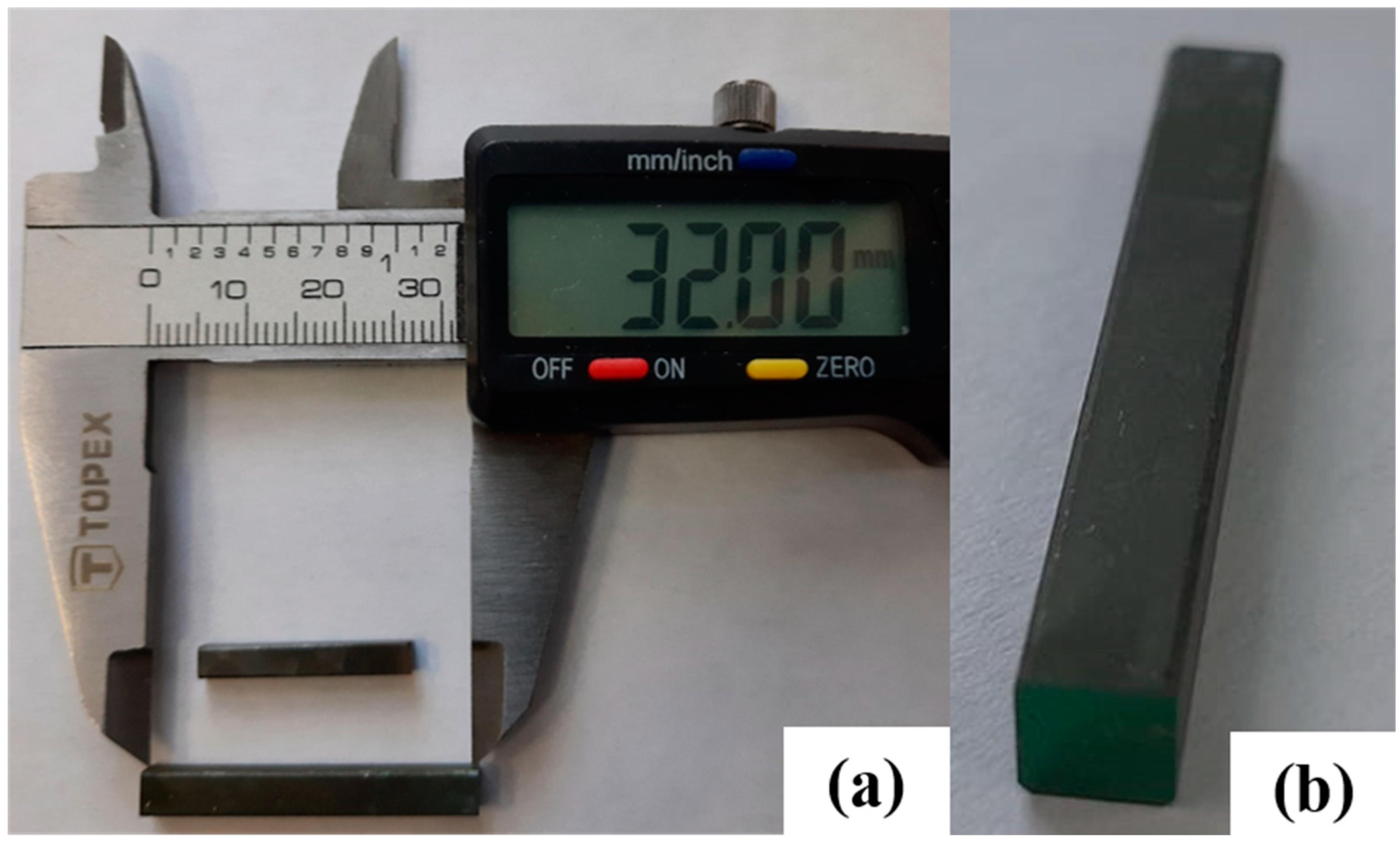
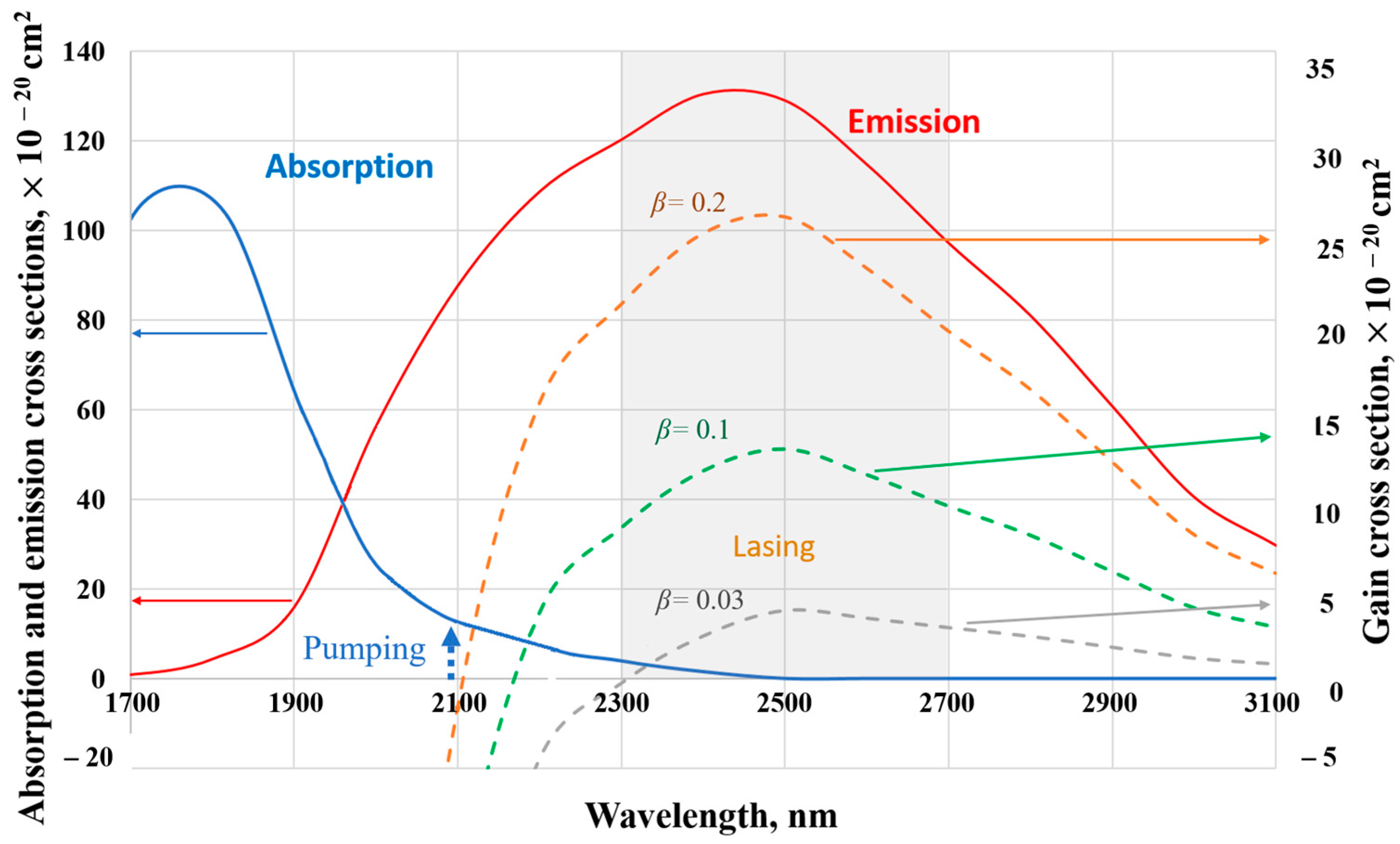

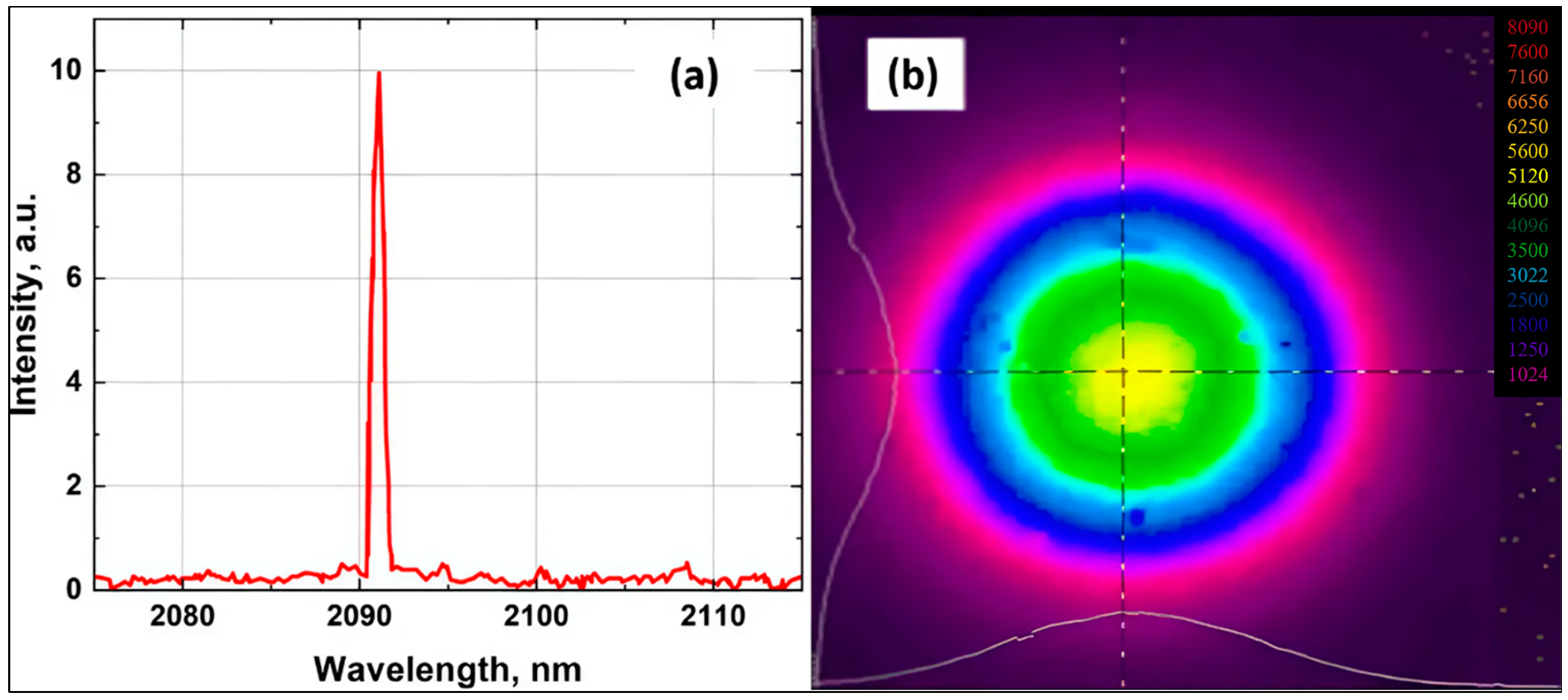
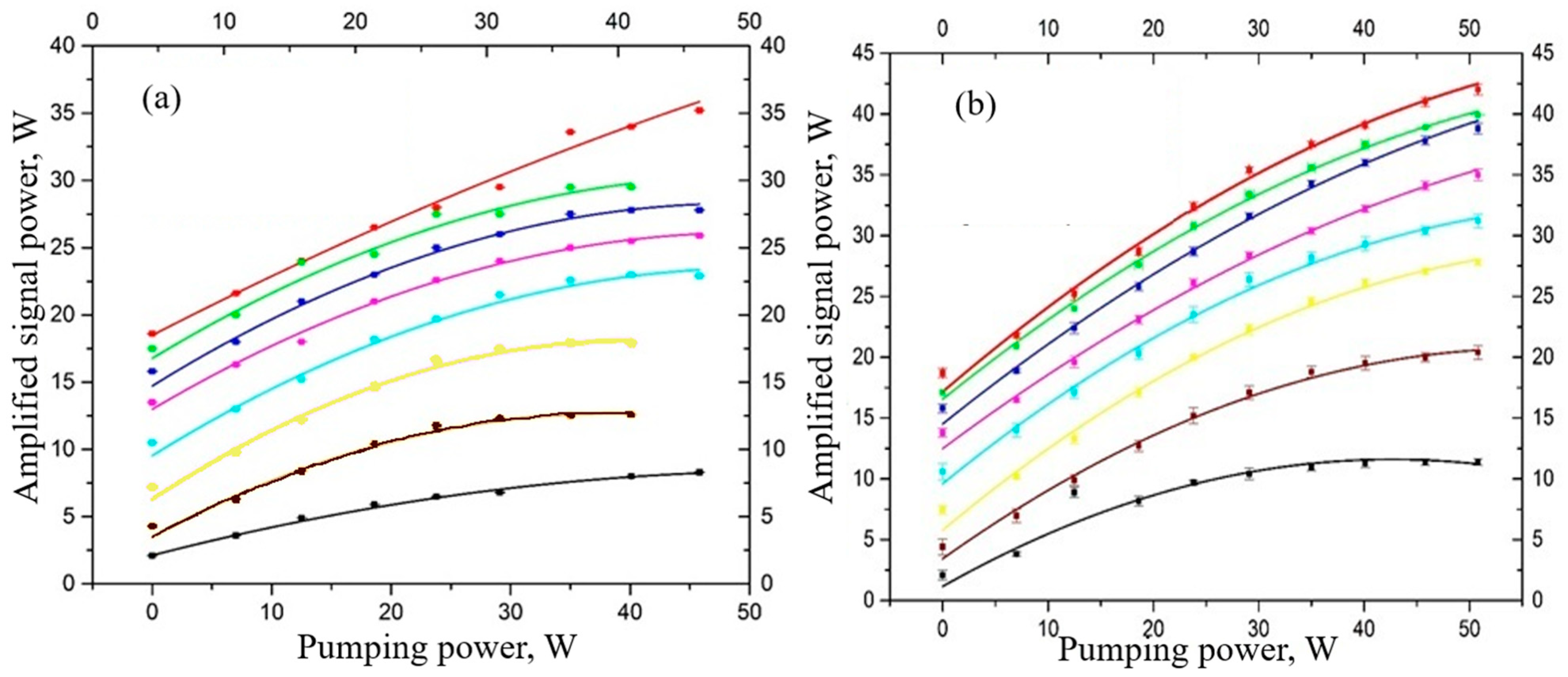


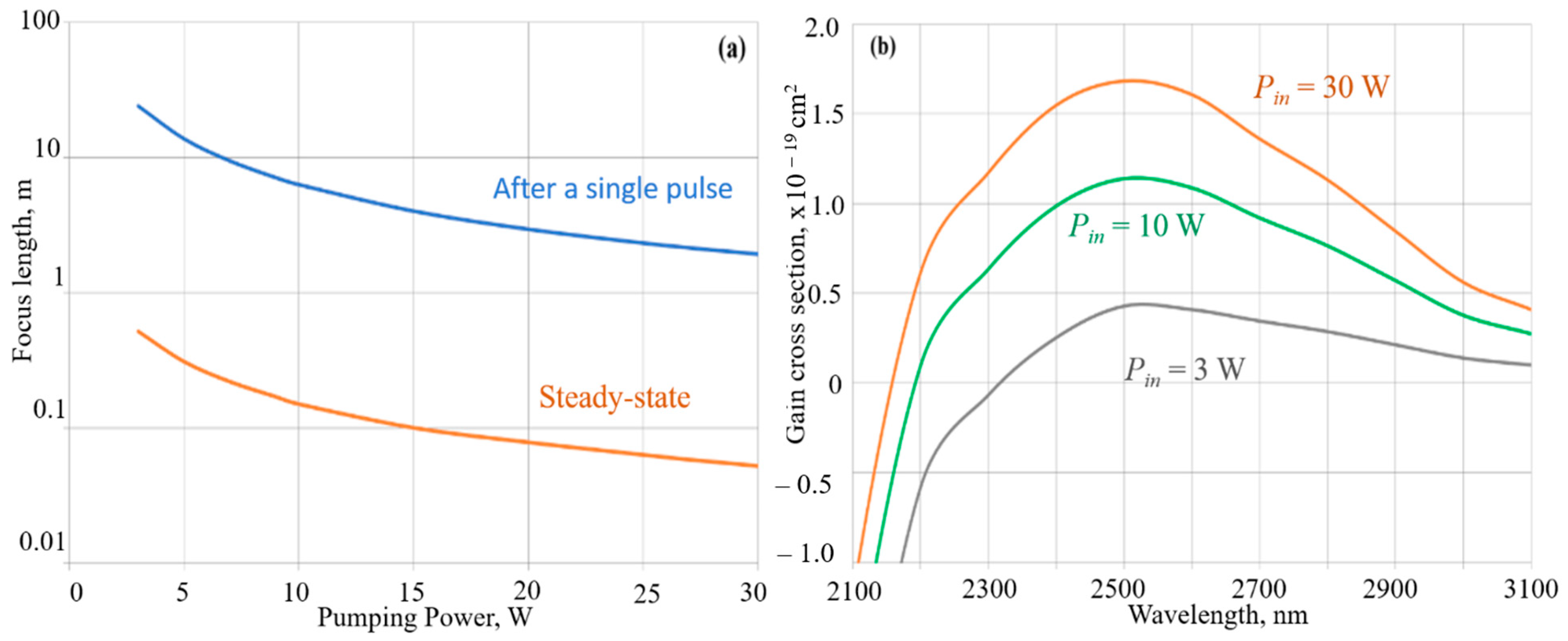
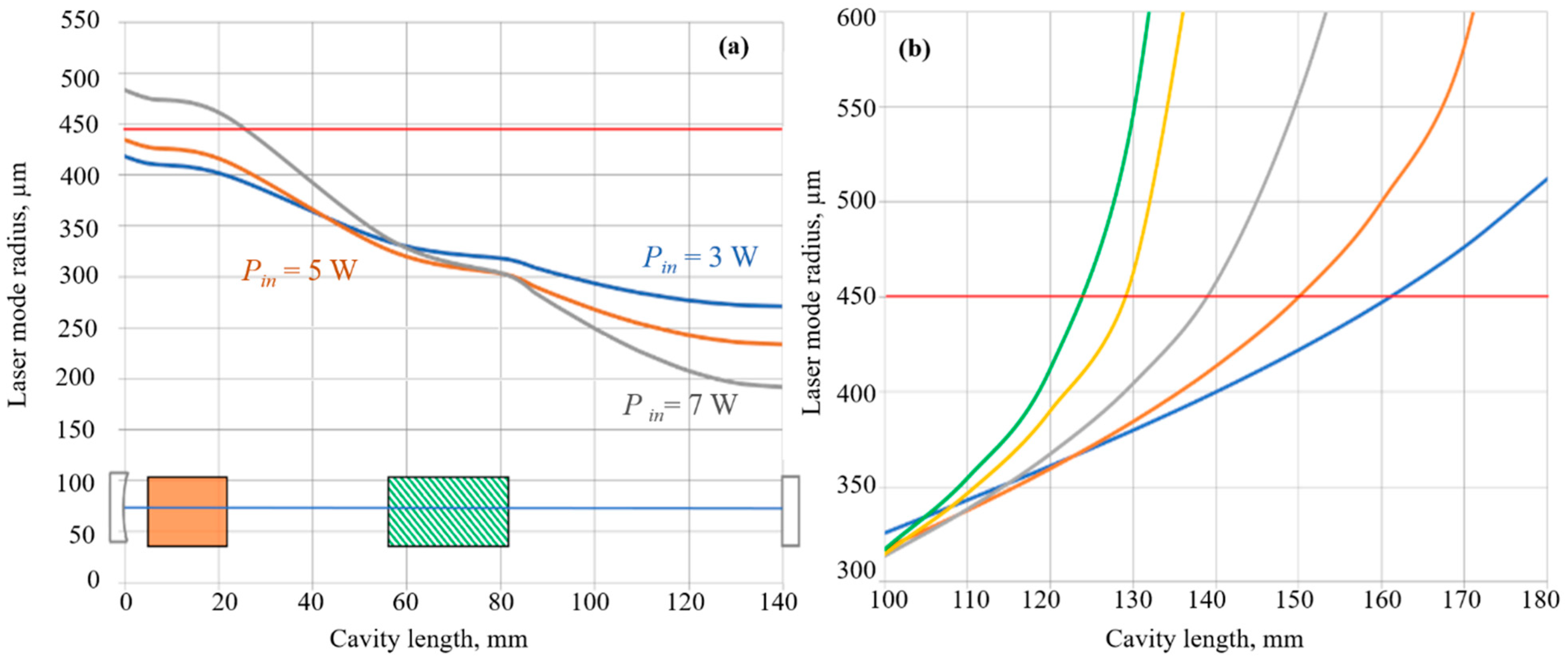
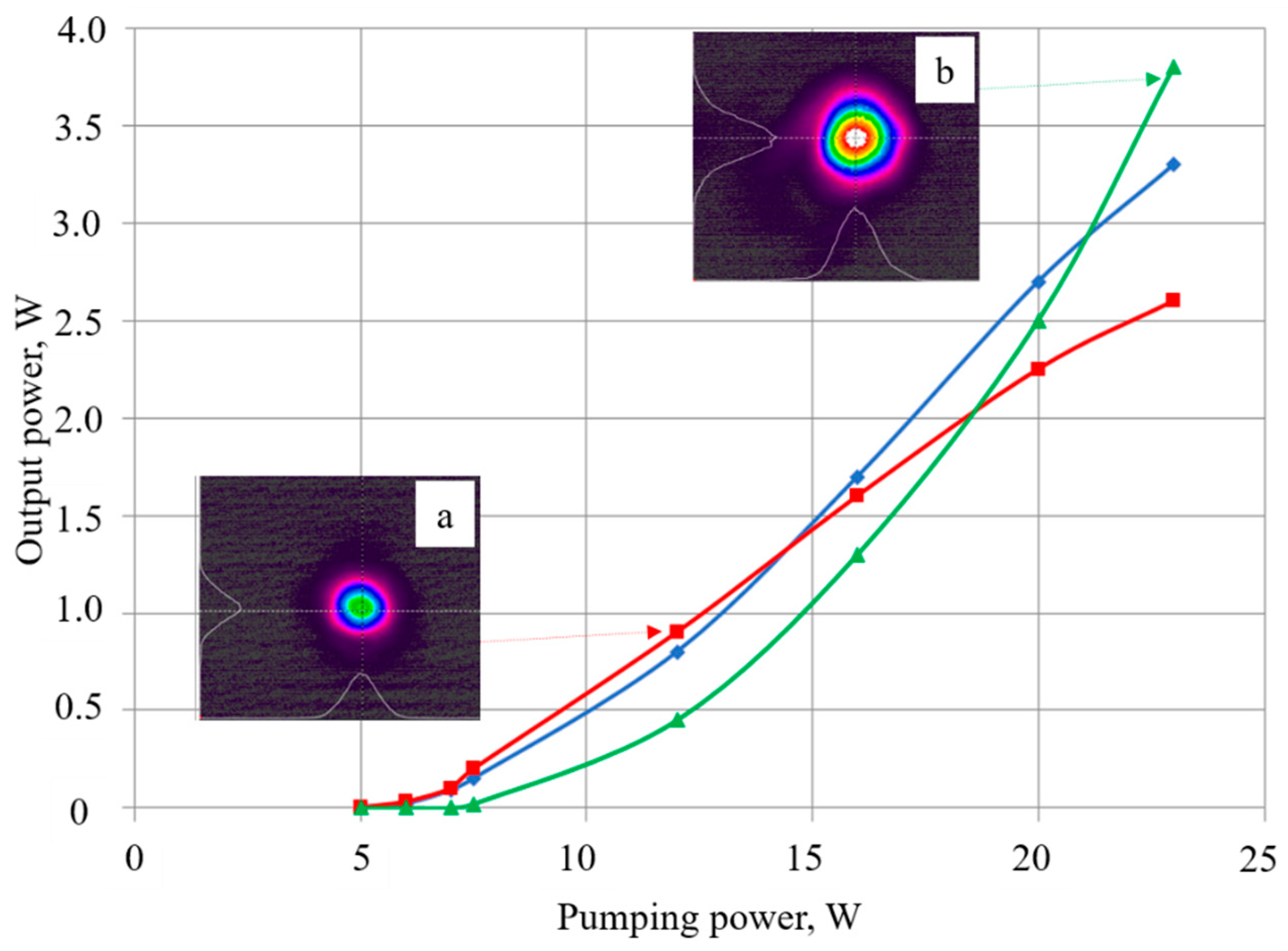


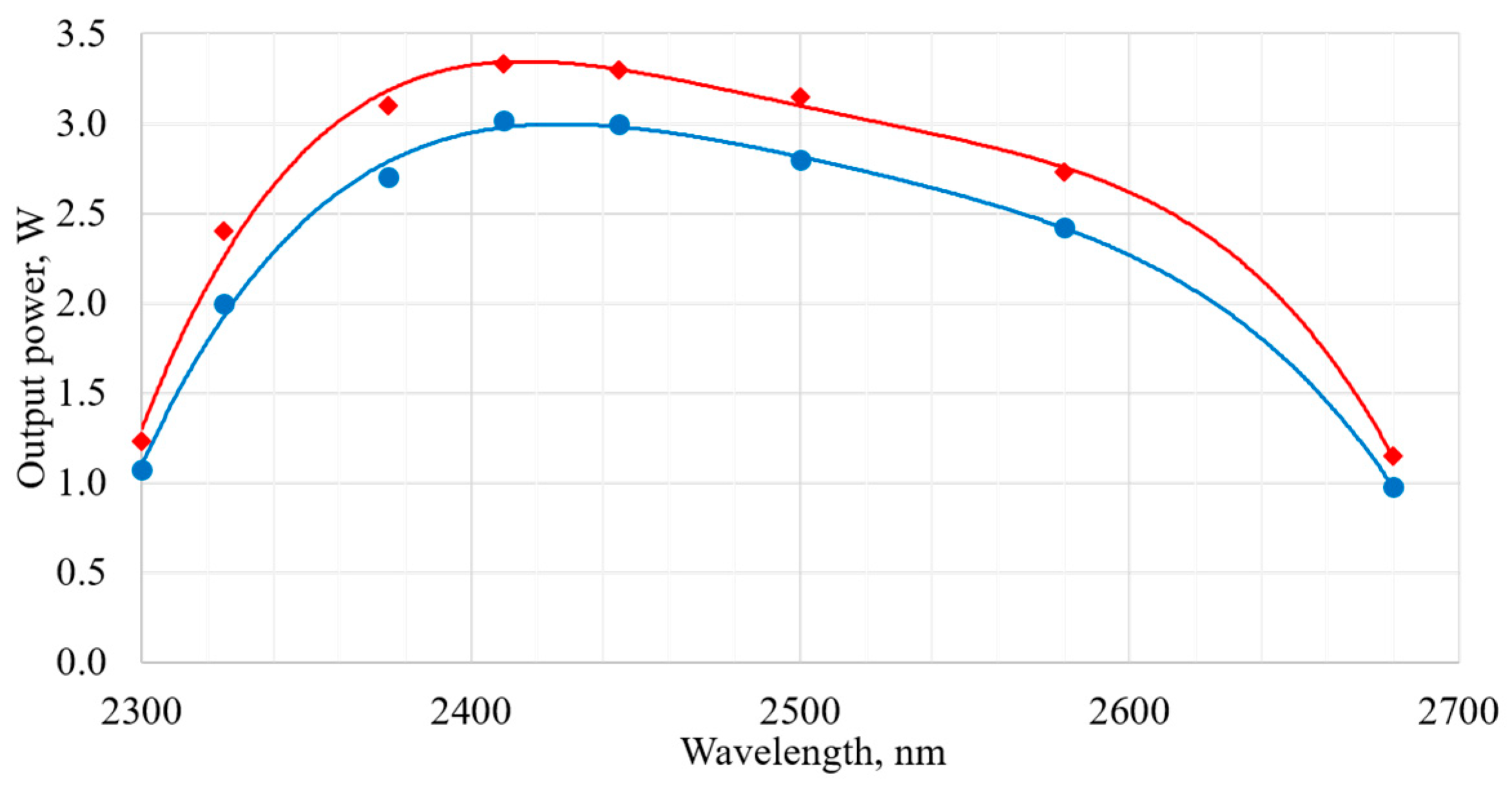

| Parameter | Value |
|---|---|
| Density of the doping Cr2+ ions, cm−3 | 5 × 1018 |
| Density of the ZnSe crystal ρ, g/cm3 | 5.27 [50] |
| Specific heat capacity of the ZnSe crystal, Cp, J/(g K) | 0.34 [50] |
| Thermal conductivity of the Cr2+:ZnSe crystal, KT, W/(cm K) | 0.18 [14,19,51] |
| Refractive index of the Cr2+:ZnSe crystal (at 2400 nm), n | 2.43 [52] |
| Thermo-optic coefficient of the ZnSe crystal, (∂n/∂T), K−1 | 61 × 10−5 [19,53] |
| Thermal expansion coefficient of the ZnSe crystal, βT, K−1 | 7.3 × 10−6 [54] |
| Absorption cross section of the Cr2+:ZnSe crystal (at 2091 nm), σabs, cm2 | 14 × 10−20 [18] |
| Emission cross section of the Cr2+:ZnSe crystal (at 2450 nm), σem, cm2 Poisson’s ratio of the ZnSe crystal, ν | 13 × 10−19 [18] 0.28 [55] |
| Length of the Cr2+:ZnSe element L, mm | 16.5 |
| Refractive index of TeO2 for the ordinary and extraordinary waves, noTeO and neTeO (at 2400 nm) | 2.17 and 2.3 [56] |
| Length of the AOTF element, mm | 25 |
| Curvature of the M1 rear mirror, mm | 300 |
| Pump beam radius ap (at e−2 intensity), µm | 450 |
| Estimated focal length of the steady-state thermal lens in the Cr2+:ZnSe crystal (at the average input pump power, Pin), fT, mm Electronic nonlinear refractive index, n2, cm2/W | 28 (at 10 W) 14 (at 20 W) 1.2 × 10−14 [11,20] |
Disclaimer/Publisher’s Note: The statements, opinions and data contained in all publications are solely those of the individual author(s) and contributor(s) and not of MDPI and/or the editor(s). MDPI and/or the editor(s) disclaim responsibility for any injury to people or property resulting from any ideas, methods, instructions or products referred to in the content. |
© 2024 by the authors. Licensee MDPI, Basel, Switzerland. This article is an open access article distributed under the terms and conditions of the Creative Commons Attribution (CC BY) license (https://creativecommons.org/licenses/by/4.0/).
Share and Cite
Antipov, O.; Eranov, I.; Balabanov, S.; Dobryinin, A.; Getmanovskiy, Y.; Sharkov, V.; Yudin, N. High-Repetition-Rate 2.3–2.7 µm Acousto-Optically Tuned Narrow-Line Laser System Comprising Two Master Oscillators and Power Amplifiers Based on Polycrystalline Cr2+:ZnSe with the 2.1 µm Ho3+:YAG Pulsed Pumping. Photonics 2024, 11, 555. https://doi.org/10.3390/photonics11060555
Antipov O, Eranov I, Balabanov S, Dobryinin A, Getmanovskiy Y, Sharkov V, Yudin N. High-Repetition-Rate 2.3–2.7 µm Acousto-Optically Tuned Narrow-Line Laser System Comprising Two Master Oscillators and Power Amplifiers Based on Polycrystalline Cr2+:ZnSe with the 2.1 µm Ho3+:YAG Pulsed Pumping. Photonics. 2024; 11(6):555. https://doi.org/10.3390/photonics11060555
Chicago/Turabian StyleAntipov, Oleg, Ilya Eranov, Stanislav Balabanov, Anton Dobryinin, Yuri Getmanovskiy, Valeriy Sharkov, and Nikolay Yudin. 2024. "High-Repetition-Rate 2.3–2.7 µm Acousto-Optically Tuned Narrow-Line Laser System Comprising Two Master Oscillators and Power Amplifiers Based on Polycrystalline Cr2+:ZnSe with the 2.1 µm Ho3+:YAG Pulsed Pumping" Photonics 11, no. 6: 555. https://doi.org/10.3390/photonics11060555
APA StyleAntipov, O., Eranov, I., Balabanov, S., Dobryinin, A., Getmanovskiy, Y., Sharkov, V., & Yudin, N. (2024). High-Repetition-Rate 2.3–2.7 µm Acousto-Optically Tuned Narrow-Line Laser System Comprising Two Master Oscillators and Power Amplifiers Based on Polycrystalline Cr2+:ZnSe with the 2.1 µm Ho3+:YAG Pulsed Pumping. Photonics, 11(6), 555. https://doi.org/10.3390/photonics11060555







